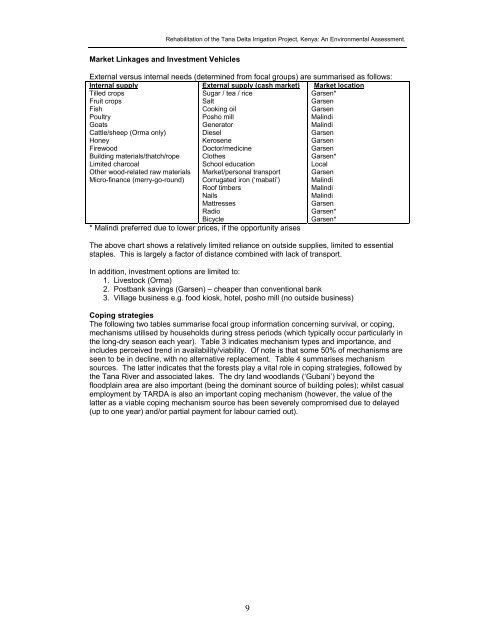Tana Delta Irrigation Project, Kenya: An Environmental Assessment
Tana Delta Irrigation Project, Kenya: An Environmental Assessment
Tana Delta Irrigation Project, Kenya: An Environmental Assessment
You also want an ePaper? Increase the reach of your titles
YUMPU automatically turns print PDFs into web optimized ePapers that Google loves.
Rehabilitation of the <strong>Tana</strong> <strong>Delta</strong> <strong>Irrigation</strong> <strong>Project</strong>, <strong>Kenya</strong>: <strong>An</strong> <strong>Environmental</strong> <strong>Assessment</strong>.<br />
Market Linkages and Investment Vehicles<br />
External versus internal needs (determined from focal groups) are summarised as follows:<br />
Internal supply<br />
Tilled crops<br />
Fruit crops<br />
Fish<br />
Poultry<br />
Goats<br />
Cattle/sheep (Orma only)<br />
Honey<br />
Firewood<br />
Building materials/thatch/rope<br />
Limited charcoal<br />
Other wood-related raw materials<br />
Micro-finance (merry-go-round)<br />
External supply (cash market)<br />
Sugar / tea / rice<br />
Salt<br />
Cooking oil<br />
Posho mill<br />
Generator<br />
Diesel<br />
Kerosene<br />
Doctor/medicine<br />
Clothes<br />
School education<br />
Market/personal transport<br />
Corrugated iron (‘mabati’)<br />
Roof timbers<br />
Nails<br />
Mattresses<br />
Radio<br />
Bicycle<br />
* Malindi preferred due to lower prices, if the opportunity arises<br />
Market location<br />
Garsen*<br />
Garsen<br />
Garsen<br />
Malindi<br />
Malindi<br />
Garsen<br />
Garsen<br />
Garsen<br />
Garsen*<br />
Local<br />
Garsen<br />
Malindi<br />
Malindi<br />
Malindi<br />
Garsen<br />
Garsen*<br />
Garsen*<br />
The above chart shows a relatively limited reliance on outside supplies, limited to essential<br />
staples. This is largely a factor of distance combined with lack of transport.<br />
In addition, investment options are limited to:<br />
1. Livestock (Orma)<br />
2. Postbank savings (Garsen) – cheaper than conventional bank<br />
3. Village business e.g. food kiosk, hotel, posho mill (no outside business)<br />
Coping strategies<br />
The following two tables summarise focal group information concerning survival, or coping,<br />
mechanisms utilised by households during stress periods (which typically occur particularly in<br />
the long-dry season each year). Table 3 indicates mechanism types and importance, and<br />
includes perceived trend in availability/viability. Of note is that some 50% of mechanisms are<br />
seen to be in decline, with no alternative replacement. Table 4 summarises mechanism<br />
sources. The latter indicates that the forests play a vital role in coping strategies, followed by<br />
the <strong>Tana</strong> River and associated lakes. The dry land woodlands (‘Gubani’) beyond the<br />
floodplain area are also important (being the dominant source of building poles); whilst casual<br />
employment by TARDA is also an important coping mechanism (however, the value of the<br />
latter as a viable coping mechanism source has been severely compromised due to delayed<br />
(up to one year) and/or partial payment for labour carried out).<br />
9

















